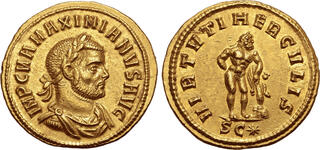Lot description:
Maximian AV Aureus. Cyzicus, AD 286-287. IMP C M A MAXIMIANVS AVG, laureate, draped and cuirassed bust to right / VIRTVTI HERCVLIS, Hercules standing facing, head to right, leaning on club set on rock, lion-skin draped over club; SC* in exergue. RIC VI 605 var. (mintmark); C. -; Depeyrot 6/4 (this coin); Calico 4758a corr. (bust type, same dies). 5.30g, 21mm, 12h.
Good Extremely Fine; a powerful rendering of Hercules. Extremely Rare; the only example on CoinArchives with this mintmark.
This coin published in G. Depeyrot, L'or du Bas-Empire, Inventaire justificatif des tomes 1 et 2, 2004, p.133, 6/4;
Ex Dr. Hans Krähenbühl Collection, Leu Numismatik AG, Auction 8, 23 October 2021, lot 368 (hammer: CHF 15,000)
Purchased from Münzen & Medaillen AG, 25 October 1963;
Ex Münzen & Medaillen AG, Auction XXV, 17 November 1962, lot 644.
In 293, Diocletian established the Tetrarchy, a system by which the empire was divided geographically into four areas and ruled by two Augusti and two Caesars. Prior to dividing power between four, Diocletian had initially promoted his ally Maximian to Augustus in 286 to rule with him as co-emperor. At the same time, Mausaeus Carausius was appointed to defend the Channel from attacks by Frankish and Saxon pirates. However, Carausius showed his gratitude towards Maximian by usurping power and declaring himself Augustus of Britain and northern Gaul. It was therefore now imperative that Maximian also had a title and position of equal status to confront Carausius on equal standing. Diocletian, having just started to bring some semblance of stability back to the empire after decades of turbulence, was determined that civil war should not break out again. By co-opting Maximian as his fellow Augustus he seemingly hoped that the unrest developing in the north of the empire would be quelled and his program of reform could continue uninterrupted. So, as part of their assumption of joint power, Diocletian and Maximian adopted tutelary deities, namely Jupiter and Hercules respectively and took on the surnames Jovius and Herculius. From this point, most of their coinage was minted with reverse legends and types honouring Jupiter and Hercules, (see Sydenham, E.A. & Mattingly, H. eds., RIC V.2, 1933, p. 213), as shown on this coin.
According to myth, the Olympians were only able to defeat the giants with the help of Hercules, whose role is only obliquely referred to by ancient writers (Hesiod, Theogony 954), but it would seem was commonly known as part of the wider myth in the ancient world. Punished for murdering his wife and children in a rage visited on him by Hera queen of the gods, Hercules was tasked with ten labours to redeem himself, meted out by his cousin King Eurystheus (two of the tasks were disqualified as Hercules was considered to have received too much help). Ultimately, when these tasks were completed, he would be rewarded with immortality by the gods. The labour referred to on this coin is the first; the slaying of the Nemean Lion, indicated by the traditional lion-skin draped over a club. This imagery emphasises Hercules' power over beasts and more broadly the taming of nature by men. This coin can therefore be seen as underpinning the two Augusti's connection with their tutelary gods and emphasising the new order established in the empire.
Estimate: 10000 GBP |  |